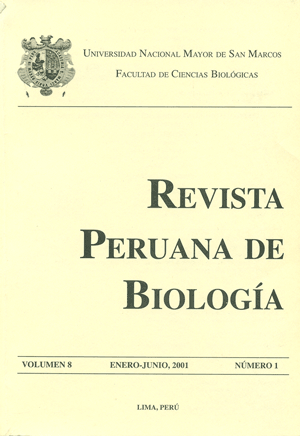Comparative phenotipic survey of microbial consortia with chitinolytic activity from marine silts and rhizosphere
DOI:
https://doi.org/10.15381/rpb.v8i1.6536Keywords:
chitinolytic consortia, marine silt, rhizosphere, heterotrophic microorganisms, phenogram.Abstract
Four samples of silts were collected from the bottom and the bank of the beach “Marbella” in Callao and four samples of cultivated land were taken at level of rhizosphere obtained from a vineyard of “Grocio Prado” Grassland’s town in the Country of Chincha. The microbial heterotrophics populations with chitinolytic activity present in these environments was determined quantitatively, being described its main phenotypic characteristics. For the quantification of the populations the method of the Most Probable Number (NMP) was used. The tubes with positive growth were sowed in tubes with Granulated Chitin Agar and Colloidal Chitin Agar that were incubated at environmental temperature for two weeks. With the developed colonies the following tests were carried out: Oxidation/Fermentation of Glucose, Oxidase, Catalase, motility, presence of flagellum, tintoreal capacity, production of spores and semiquantitative chitinolytic activity. The phenograms were elaborated with the NTSYS v.1,7 program. The biggest density of chitinolytic bacteria was found in rhizosphere reaching levels of ³1,6 x 105, as long as in marine silts the density oscillated among 2,2 x 102 to 1,6 x 104 NMP/g. After the analysis of clustering of the phenotypes shown by the studied consortia it was found that they presented distinctive characteristic, exhibiting both of them a great phenotypic diversity.Downloads
Downloads
Published
Issue
Section
License
Copyright (c) 2001 Débora Alvarado, Lidia Flores, Ana María Guerrero, Zuleyka Vicente, Ruth García

This work is licensed under a Creative Commons Attribution-NonCommercial-ShareAlike 4.0 International License.
AUTHORS RETAIN THEIR RIGHTS:
a. Authors retain their trade mark rights and patent, and also on any process or procedure described in the article.
b. Authors retain their right to share, copy, distribute, perform and publicly communicate their article (eg, to place their article in an institutional repository or publish it in a book), with an acknowledgment of its initial publication in the Revista Peruana de Biologia.
c. Authors retain theirs right to make a subsequent publication of their work, to use the article or any part thereof (eg a compilation of his papers, lecture notes, thesis, or a book), always indicating its initial publication in the Revista Peruana de Biologia (the originator of the work, journal, volume, number and date).






